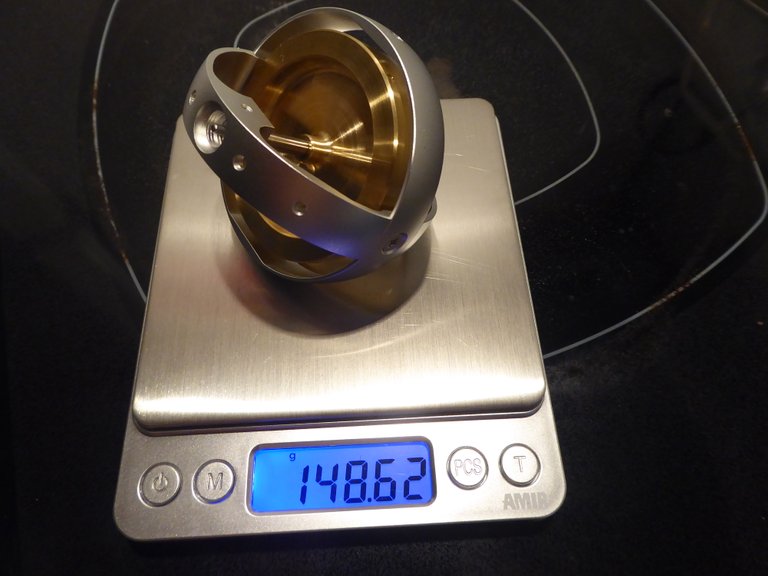🔬#MESExperiments 14: Angle of Gyroscope Has Little Effect on Rate/Period of Precession #Interesting
In #MESExperiments 14, I demonstrate a very interesting finding that I had not previously suspected with gyroscopes and that is the steepness of the angle of precession has very little direct effect on the rate of precession. Note that in this context I refer to the rate or “period” of precession as the number of precession revolutions per time (in this case per minute hence RPM) and should be distinguished from precessional or angular velocity which is the actual speed of the center of mass moving in precession. This observation of the precession rate being unaffected by the steepness of the angle indicates both that the angular velocity of the center of mass is increasing as the angle is steeper (since the gyro has further distance to precess) but also that there is an underlying symmetry taking place between the gyro spin speed and the rate of precession.
Furthermore, my prior intuition was that the steeper the gyroscope the more “torque” would be imposed which should drive both the precession rate and velocity faster to maintain its (anti-gravitic) levitation. But given my earlier experiments of gyroscopes literally behaving massless in precession, it seems fitting and more reasonable that precession has a much more correlated and direct connection to the spin speed than conventionally understood.

Four gyroscope tests were performed in this experiment and at angles: 31°, 45°, 65°, and 84° from the vertical. The full results are show in the Excel Spreadsheet file and corresponding tables and charts below.
https://1drv.ms/x/s!As32ynv0LoaIh_F1zEvJGUMvdW_6zw?e=B3X619
Retrieved: 9 August 2019
Archive: Not Available


Note that the RPM measurements were averaged for each measured interval but for the underlined data in the 65° gyro (shown below) the intervals were extended because the intervals at that time frame were a relatively smaller sample size when dealing with whole seconds. Looks like I have to get a more accurate timer…
Note: The bold revolutions counts are subtracted by 1 since I accidentally skipped the 233 count. Fortunately only the one precession rate of 99.00 (in bold) has changed from the previous 103.00 since the calculation is relative so later calculations are still the same.


The precession rate for all the tests are shown in the charts below. The first chart includes all data points. Notice that the precession rate is very similar for all the tests both in its increasing phase and (also very interesting) decreasing phase. The 4 data points above 130 RPM are for the start of the “spiral downwards phase” for the two gyro tests that had risen fully vertical (31° and 45° gyros) and thus represent a unique phase that requires further study. It appears that the gyros get “thrown” off quickly from the vertical phase which could help explain both the fast precession rate as well as the steep drop in precession rate as gyro become steeper and then exhibit conventional precession rates.

The chart below does not include the data points above 130 RPM. Notice how the precession rates all follow a very similar pattern. Also interesting is that there appears to be a "peak precession rate" after which further elapsed time and hence slowdown of the gyro spin speed gradually results in a slowdown of the precession rate, which is also a case for further study.

The chart below shows the data only for the phase where the precession rate is increasing. Notice that the near horizontal 84° gyro fell down at its highest precession rate and thus didn't exhibit the typical "peak precession rate" as the other gyro tests in the above charts; this is definitely worthy of further study. And note how incredibly similar the precession rates line up for all four gyro tests. #Amazing

The chart below shows only the latter section of the overall chart and in which the precession rate drops. Notice again the three gyro tests at this stage are all very similar. The only difference is that they are separated in elapsed time since the 65° gyro did not rise perfectly vertical to get to its “sleep” position which usually means it will fall sooner.

Measurement Data and Links
The gyroscope used in these tests weighed 150.68 grams (including the stem) and the video links to each test is shown below:
- 31° Angle: https://youtu.be/18pEg59qWJ8
- 45° Angle: https://youtu.be/EllJo1TP_As
- 65° Angle: https://youtu.be/zLS3t41DjJk
- 84° Angle: https://youtu.be/8FuvSUhSElU
Screenshots of Each Time Interval
The data used in the spreadsheet is taken from the following screenshots at more or less every 15 seconds. The precession revolutions are counted from the initial angle measurement position.







































Revolutions Count Error
Please note that I accidentally skipped over the 233 revolutions count for the 65° gyro test and instead wrote it as 234. Thus all subsequent counts should be subtracted by 1. Here are the screenshots of the skip over:


Gyro Weight Measurements
The weight of the gyroscope used in this experiment is 150.68 g with the stem, 148.62 g without the stem, and the stem is 150.68 – 148.62 = 2.06 grams.
Stay Tuned for #MESExperiments 15…
Watch Video On:
- 3Speak: https://3speak.tv/watch?v=mes/rcdrjlgd
- Odysee: https://odysee.com/@mes:8/mesexperiments-14-angle-of-gyroscope-has:5
- BitChute: https://www.bitchute.com/video/mkRKIIRMgjW8/
- Rumble: https://rumble.com/v1ybh4a-mesexperiments-14-angle-of-gyroscope-has-little-effect-on-rateperiod-of-pre.html
- DTube: https://d.tube/#!/v/mes/Qma8uhwCQJhfyBWwszirJNpaEUAa5mbdKm3KjaBUgVW7Gx
- YouTube: https://youtu.be/838DeyrEwy0
View More Amazing Videos:
- #MESExperiments Video Series: https://peakd.com/experiments/@mes/list
- DRAFT #MESExperiments Video Series: https://mes.fm/experiments-draft
- #AntiGravity Video Series: https://peakd.com/antigravity/@mes/series
- #FreeEnergy Video Series: https://mes.fm/freeenergy-playlist

